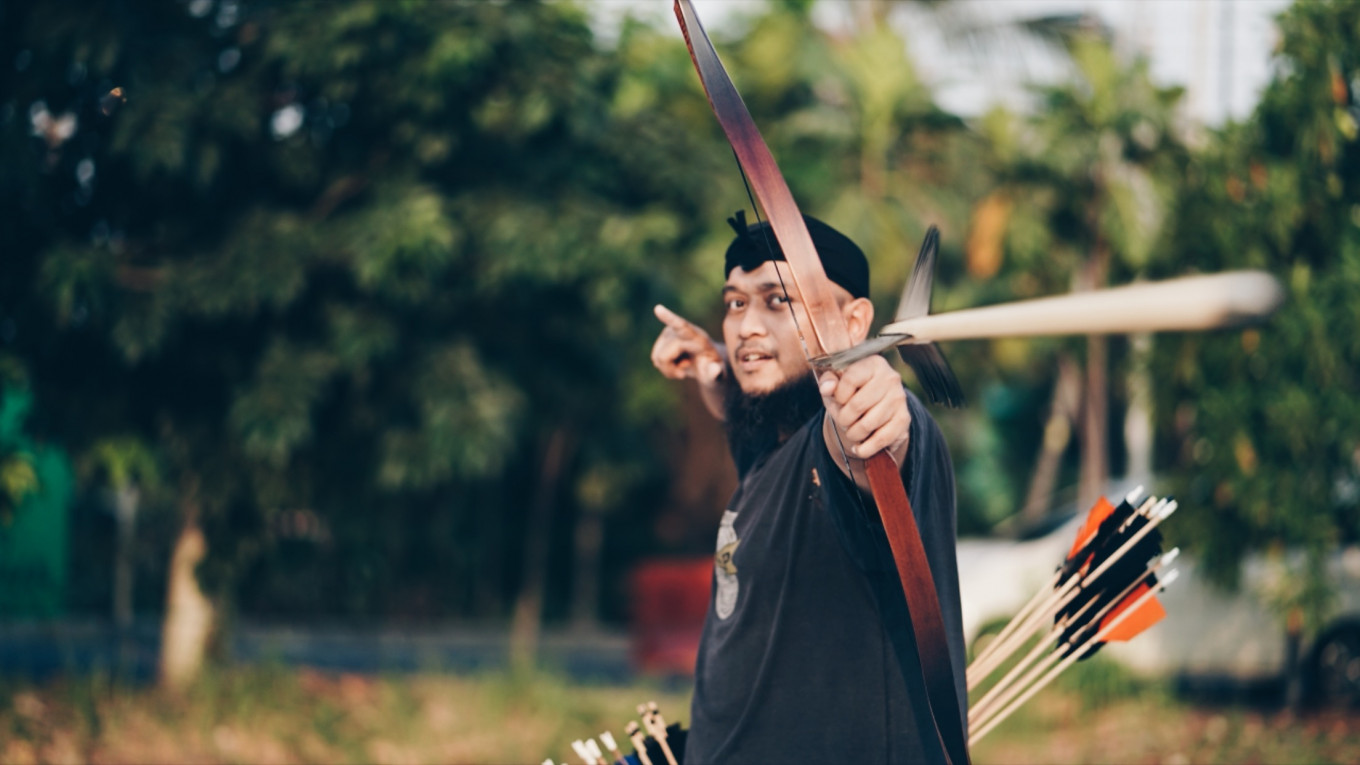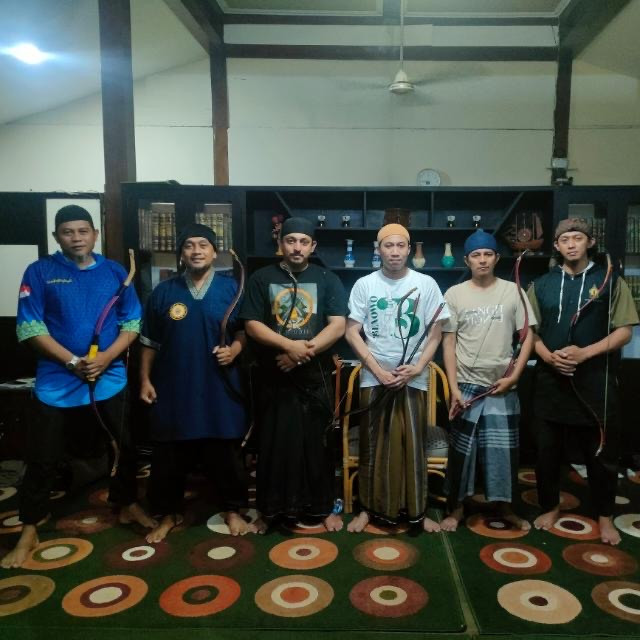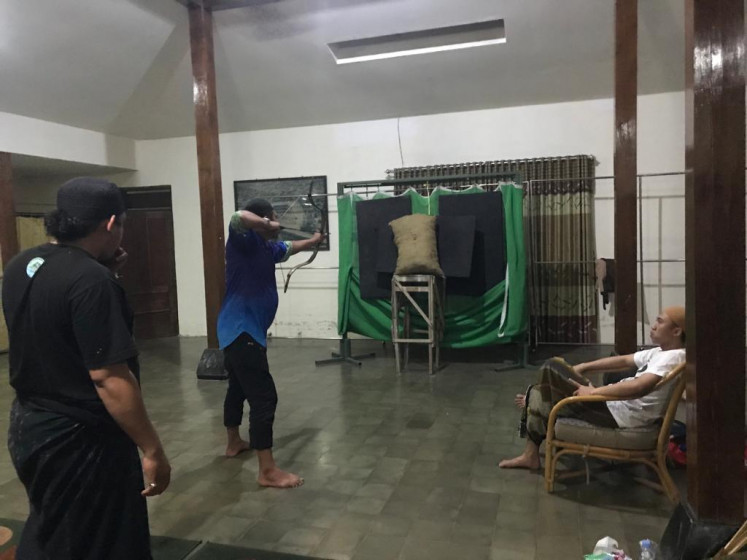Popular Reads
Top Results
Can't find what you're looking for?
View all search resultsPopular Reads
Top Results
Can't find what you're looking for?
View all search resultsPracticing Khorasani archery with Cahaya Tua Dari Khurasan
Change text size
Gift Premium Articles
to Anyone
A
rchery holds a special place in Islam. Prophet Muhammad was once recorded saying “verily, strength lies in archery”. Many Muslims today, including Habib Qori and his students, learn and practice archery to keep the prophetic tradition alive.
Archery is widely considered one of the three physical skills a Muslim should excel in, along with swimming and horse riding. In a hadith in the book Fadailur Ramyi Fi Sabilillah, Umar ibn al-Khattab, a companion of the Islamic prophet Muhammad and the second caliph of Islam, said, "teach your children swimming, archery and horse riding".
Prophet Muhammad himself often discussed the importance of archery for Muslims. Today, many Muslims aspire to master the art, including Qori bin Idrus bin Husain bin Muhsin al-Khered and his student, Nizam al-Qodiri, both of whom are Habib (the Indonesian equivalent to the title Sayyid, which is reserved for descendants of the Prophet by his daughter Fatimah).
With the help of Nizam, Qori founded Cahaya Tua Dari Khurasan (officially Yayasan Pendidikan Cahaya Tua Dari Khurasan or the Elder Light of Khorasan Educational Foundation), an archery school focusing on the techniques as instructed by three Umayyad archery imams (leaders), namely Abu Hashim al-Bawardi, Tahir al-Balkhi and Ishaq ar-Rafa, all of whom lived in the historical region of Greater Khorasan, an area comprising present-day north-eastern Iran, the majority of Afghanistan, a large part of Central Asia and sometimes beyond.
"I serve as the chief instructor at this institution while Habib Nizam is the general supervisor for the entirety of Indonesia. I also hold several positions at other archery institutions. I serve as a head of Traditional Archery Research and Studies at PERDANA Indonesia, a member of the board of supervisors at FESPATI and an advisor at several regional archery clubs. In Malaysia, I also serve as an advisor at As-Sibbaq Horseback Archers Association, Zawra Archery Johor and Royal Archery Sabah," Habib Qori, a native of Sumbawa, said.
"Habib Qori also teaches hadith at Dauroh Hadits Ma'had Al Fatah in Magetan," said Nizam, 31, who claimed to be a full-time archer. "I have been a student of Habib Qori since I started doing archery."
Qori said he started learning archery from his teacher, Syaikh Datuk Alimuddin, when he was in the third grade. "But I began learning archery seriously when I trained under Syaikh Umar al-Naqshabandi. He was also the one who motivated me to translate [into Indonesian] the book al-Furusiyyah al-Muhammadiyah by Imam Ibn Qayyim [al-Jawziyya]. I began focusing on writing about and studying archery about six years ago, around the time of the birth of my daughter," the 36-year-old said.
"I began focusing on studying the Khorasani technique since I began writing the book Teknik Memanah Dalam Islam (Archery Technique in Islam). So, after reading Ibn Qayyim's book, I presented it to my teacher, Syaikh Umar an-Naqshabandi. I said I wanted to translate the book, and he said, 'I have read that book since a long time ago'. Then, we began discussing the techniques in the book."
First generation: Qori (third from right) is posing with Angking (left), Ande Pangeran and Nizam al-Qodiri (right), all of whom are among the first generation of pewaris. (Courtesy of Angking) (Courtesy of Angking/Courtesy of Angking)Scientific and religious backing
Qori explained that there are only four schools of jurisprudence within Sunni Islam, namely Hanafi, Hambali, Maliki and Syafi'i, There were also only three schools of archery practiced by the Muslims in the past: Hashimi, Tahiri and Ishaqi, named after the aforementioned archery imams.
"This [collection of techniques] is backed by scientific evidence. Other than the book al-Furusiyyah al-Muhammadiyah I also have around 30 other manuscripts," Qori said. The manuscripts include al-Idhah fi-Rimayyah by Muhammad Yusuf al-Ikhbari; al-Wadheh by Abdurrahman at-Tabari; and al-Ghunyah [al-Tullab fi Ma'rifat al-Rami bi-al-Nushshab] by Taybugha al-Ashrafi al-Baklamishi al-Yunani, who lived in the mid-1300s. These manuscripts, he explained, explore in detail the techniques as instructed by the three imams.
Qori then explained that the fact he drew his sources from 600-year-old handwritten copies of archery manuscripts was what distinguished his school from other archery clubs. "I have been given the ability to read these manuscripts… and since the manuscripts are all ancient, we named the school Cahaya Tua Dari Khurasan," Qori said.
The students of Cahaya Tua Dari Khurasan are called pewaris (heirs) as they are said to inherit the elder light of Khorasan through Qori. Two of Qori's first heirs to the light are Angking, who preferred to share only his nickname, and Ande Pangeran, a frequent champion of national and local competitions.
"Our curriculum is deeply rooted in the manuscripts -- the physical and mental pillars of archery. The five physical pillars are qobd [the grip], aqdu [the lock], madd [the draw], nadzor [the aiming] and itlaq [the release], while the mental pillars are speed [referring to the rate at which one releases their arrow, not the velocity of the arrow itself], accuracy, strength and caution," said Ande, who is also a Mamluk archery practitioner.
Archery as a prophetic tradition
Ande said he was interested in learning the technique because it was "very detailed" and proved effective as it helped the Muslims "rule the world during the Islamic golden age". Meanwhile, Angking said he learned the technique because "this was the technique of the Muslims in the past, and as a Muslim, I was interested in studying the technique".
While there are many Islamic and Islamicate archery techniques, including that of the Ottomans and the Mamluks, Angking said they ultimately drew their sources from the three Khorasani imams. Angking then explained that due to the technique being a collection of instructions, it offers some degree of flexibility for its practitioners.
"Everyone is different. In Imam Abu Hashim's technique, some aspects are the total opposite of that of Imam Tahir. For example, Imam Abu Hashim stood perpendicular to the target, while Imam Tahir stood facing the target. Meanwhile, Imam Ishaq stood obliquely toward the target," Angking said.
The differences continue almost throughout the entirety of the techniques, with Abu Hashim and Tahir being opposite to each other, while Ishaq's instructions fill the void between the two.
"Imam Abu Hashim drew from top to bottom, while Imam Tahir drew from bottom to top and Imam Ishaq drew straight," Angking continued. "Ultimately, you can combine the techniques. For example, you are allowed to draw in the style of Imam Abu Hashim and release in the style of Imam Tahir."
Qori explained that there were many benefits of archery, including improving one's physical fitness and focus. "However, they are all secondary. The most important reason is because it is a sunnah [prophetic tradition]," Qori said.
"I really hope that all pewaris would devote themselves to the sunnah of the prophet until the end of their lives [in addition to] devoting themselves to the religion and the nation – [and] not do this because they seek wealth, fame and praise. May Allah protect us from materialistic and worldly needs," he continued.
"I, myself, position myself as a servant to the ummah [community] of the Prophet. Devoting oneself to the sunnah will increase one's love for the Prophet."













